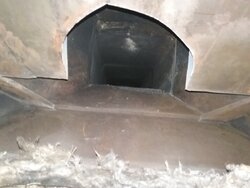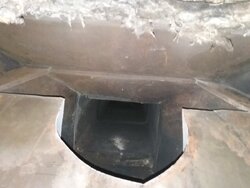I'm working on getting my firebox ready in order to drop a new liner in my chimney and hook up my Hearthstone Hearthmount stove. I got a good deal on a used unit and now need to tackle the chimney.
I removed the old unit, which had a fan and would not heat the home without electricity running, and am now cutting the box to make room for the liner.
The chimney is concrete block from the basement floor, one level down from my install, all the way through the attic and the roof, with brick on the outside.
The pics that follow show how I've cut the firebox (not sure if that's the correct name - the large steel case installed at the time the chimney was built). I can fit a flexible liner through it, but would prefer solid pipe. My question is; Can I cut away more of the steel box? Do I need to be concerned about cutting too much? Any pipe I install will be at least 18" from the exterior of the metal box, and it is against concrete block.


I removed the old unit, which had a fan and would not heat the home without electricity running, and am now cutting the box to make room for the liner.
The chimney is concrete block from the basement floor, one level down from my install, all the way through the attic and the roof, with brick on the outside.
The pics that follow show how I've cut the firebox (not sure if that's the correct name - the large steel case installed at the time the chimney was built). I can fit a flexible liner through it, but would prefer solid pipe. My question is; Can I cut away more of the steel box? Do I need to be concerned about cutting too much? Any pipe I install will be at least 18" from the exterior of the metal box, and it is against concrete block.






